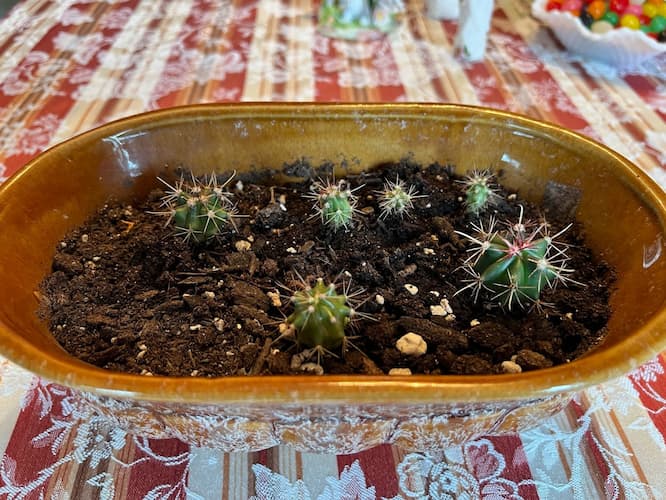How to grow Houseplants from Seeds

About Growing Houseplants from Seeds
Most homeowners grow houseplants. It might be a Poinsettia plant leftover from Christmas, small plants inside of a Terrarium, floor plants, hanging baskets with vining plants growing down from it, or any number of varieties of plants that thrive (or simply survive) indoors during winter months. Most often, houseplants come from the store or are received as a gift. The plant is already growing. You just take care of this living plant. Your challenge is to keep it alive and growing…indoors. However, did you ever think about taking the next step?….. growing houseplants from seed. It’s a bit more of a challenge, yet a lot of fun. It immensely opens up the types of plants you can grow indoors.
Sowing seeds to grow as houseplants is not really different than starting seeds for transplanting outdoors in your garden. Instead of transplanting them into your garden when the weather warms in the spring, you grow them indoors.
Accordingly, you will find below, some of our suggestions of the types of houseplants to grow indoors from seeds and information on how to grow them.
By definition, a houseplant seed is any seed that you use to grow a plant indoors. Now, that’s a lot of potential candidates.
Types of Seeds for Indoor Transplants
Technically, almost any seed can be used to grow a plant as an indoor houseplant. Experiment if you’d like. After all, a lot of the fun of gardening is in experimenting, and the challenge of growing something unique, or in a unique environment.
From a practical sense, the selection of seeds narrows to smaller plants, that require less light, and those that do well in an indoor environment.
Here are some of our suggestions:
Herbs as Houseplants
As a rule of thumb, herbs are great plants to grow indoors. Select plants that grow short, from a few inches to a foot. As they grow, you can use them in the kitchen! Growing them indoors from seed is the way to go. Our top suggestions are:
Basil: This plant does well indoors. A sunny window is best. It will be lots of fun to make pesto and your favorite recipes, using basil fresh from your indoor houseplant. Some grocery stores sell basil plants in the produce department. They are intended to use the fresh leaves. But, the plants have roots. You can take them home and use some of the leaves. Then, plant it to grow even more leaves.
Cat Grass and Catnip -You’ll love it, and so will your cats. Caution: Keep the plant out of reach of your cats until you are ready to let them have it.
Chives: One of the easiest plants to grow indoors or out. These cold-hardy perennials don’t mind a cool, drafty windowsill. They will benefit from bright sunlight.
Cress: It grows just 4 to 6 inches tall. It is a great addition to your winter salad greens.
Lavender: The plant needs full to partial sun. Its scent is a real pleasure when blooming indoors.
Parsley: Cook and garnish with fresh parsley all winter long. Then, plant this biennial into the herb garden in early spring.
Tarragon: This plant may grow a little tall (up to 18″) for limited spaces. But, if you have the room, you will enjoy growing Tarragon as a houseplant.
Flowers as Houseplants
Shade-loving plants and rock garden plants are great candidates to grow as indoor house plants. Shade lovers are often grown for their foliage. And they are readily adaptable inside your home. Among the many ideas, we recommend:
Alyssum: These low-growing plants will look pretty in just about any plant container.
Cactus – Take up the challenge and grow them from seeds!
Coleus: People grow them for their colorful foliage. Coleus are really popular indoor plants. Try them in a hanging basket.
Bulbs and Corms: They are not seeds. But, forcing flowering bulbs to bloom indoors is a favorite indoor winter hobby of many gardeners. The top candidates include Amaryllis, Daffodils, Paperwhites, and Tulips. See How to Force Bulbs
Vegetables as Houseplants
While you “could” grow vegetables indoors, few are ideal candidates. Most need full sunlight and take up a lot of space. Imagine growing a pumpkin plant with an indoor grow light. The plant takes off, with vines growing 15′-20′ across your living room. Given plenty of sunlight, we suggest these candidates:
Lettuce and other greens, like spinach and Swiss chard, are all possibilities. Your task is to get them enough light to grow properly. We strongly suggest grow lights.
Radishes: Like other garden vegetables, it needs full sunlight. But, its small size and quick-growing habit, make it a potential indoor vegetable plant.
Green Onions: Scallions and green onions take up little space. These hardy plants can be placed near a cool, drafty window. And, they tolerate a little less than full sunlight.
How to Grow Houseplants from Seeds
Seed Starting – For indoor houseplants, start seeds in the pot or container that they will live in all winter. We recommend a heated germination mat, to help promote successful seed germination. More on Seed Germination and indoor plant care.
Keep soil moist, not wet. Wet soils lead to damping off disease. It is a common and fatal seedling disease.
Your indoor plants will need fertilizer. Apply regular applications of liquid fertilizer. Or, use houseplant fertilizer spikes.
Providing your new houseplant with plenty of sunlight is absolutely essential. Sunlight. Chances are that your indoor environment will not provide enough sunlight for your plants. So, don’t wait for the plants to appear pale, thin, and lanky. Use indoor grow lights regularly.
Related Articles
Also, people who read this article will like:
How to Grow Houseplants – Indoor plant care
Please support our site. Shop for:
- rmmatthews100@hotmail.com
- 585-721-6528
- Rochester, NY
©1999-2024 GardenersNet.Com, All Rights Reserved

